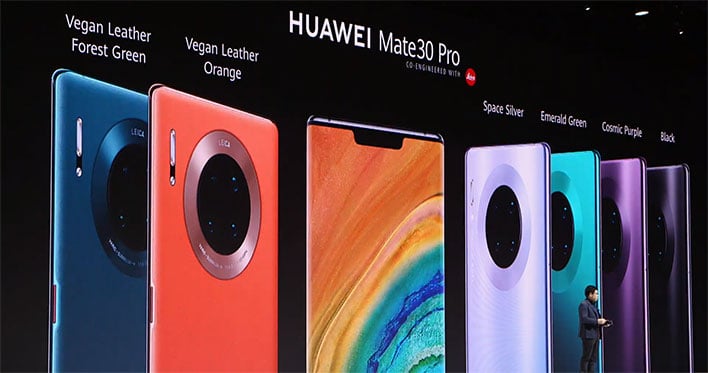Huawei Mate 30 Family Launched With Kirin 990, Quad Cameras, 7680fps Slo-Mo

The iPhone 11 series is not even shipping to customers yet, and already Huawei is looking to make Apple's latest flagship design look outdated. How so? Huawei launched its Mate 30 series today, and the message it wanted to hammer home is how the company about rethinking the design of a premium phone, which in part includes moving on from a square rear camera matrix to a sleeker (or "exquisite," in Huawei's words) Halo Ring.
"Today we bring new innovation," said Richard Yi, CEO of Huawei's Consumer Business Group.
Critics of Apple often point to a lack of innovation in the post-Steve Jobs era, and while that assessment might be a bit unfair, Huawei's theme for its Mate 30 series is the opposite. From Huawei's vantage point, the Halo Ring design that houses the four rear cameras on its latest phone mimics the look of a "professional camera." It's a small resemblance, though to my eyeballs, it is certainly a better looking implementation.
This camera-inspired design language extends to the top and bottom of the Mate 30 series, though I think Huawei is making a bigger deal out of this than it warrants. Still, the Mate 30 lineup looks the part of a premium handset series. What is perhaps more interesting is the curved "Horizon" display on the Mate 30 Pro. It wraps around the side and curves 88 degrees, thereby creating a button-free design.
The Mate 30 Pro features a 6.53-inch Flex OLED display with a 2400x1176 resolution (18.4:9 aspect ratio) while the regular Mate 30 checks in with a 6.62-inch Rigid OLED screen (it does not curve along around the edges) with a 2340x1080 resolution (19.5:9 aspect ratio). Both are powered by Huawei's Kirin 990 SoC, which features an octa-core processor and a 16-core Mali-G76 GPU.
Huawei has been aggressively pursuing 5G connectivity, and as such, the Mate 30 and Mate 30 Pro will come in both 5G and 4G flavors.
Camera performance is where Huawei is focusing most of its attention on, however, and that's not surprising. The Mate 30 Pro wields a 40MP "Cine" camera, 40MP "SuperSensing" camera, an 8MP telephoto camera, and a 3D depth sensing camera.
As Huawei explains it, the SuperSensing camera is a dual-sensor camera array featuring a 1/1.54-inch sensor paired with a 1.1.7-inch sensor. The Cine camera has an IOS of 51200 and records videos at up to 4K at 60 frames per second. There is also a slo-mo mode that records at an astounding 7680 fps.
The camera arrangement in the regular Mate 30 is similar, except the 40MP Cine camera gets traded for a 16MP ultra-wide camera, and the 3D depth sensing camera is swapped out for a Laser Focus sensor.
Huawei claims its phones excel at low light photography. To drive the point home, Huawei compared night shots taken from a Mate 30 Pro with Samsung's Galaxy Note 10+. The Mate 30 Pro's photos are clearly better. The strategic comparison leaves out the iPhone 11, which is supposed to thrive in low light situations as well.
As expected, Huawei trotted out a Porsche Design version of the Mate 30, with genuine leather. It is arguably the best looking phone of the bunch, depending on your vantage point. As for the regular versions, they will come in Space Silver, Emerald Green, Cosmic Purple, Black. There will also be a couple of vegan leather options, including Forest Green and Orange.
Pricing starts at €799 for the Mate 30 with 8GB of RAM and 128GB of storage, €1,099 for Mate 30 Pro with 8GB of 256GB of storage, €1,199 for the Mate 30 Pro 5G with 8GB of RAM and 256GB of storage, and €2,095 for the Mate 30 Pro Porsche Design with 12GB of RAM and 512GB of storage.
There's no word on when these handsets will release or how much they will cost in the US, assuming they find their way stateside. One curious wrinkle to all this is the tiff between the US government and Huawei (and China). Related to that, the Mate 30 series launches without the benefit of licensed Google apps, including access to the Play Store.
In light of this, Huawei is using its own version of Android called EMUI10 and is launching its own app store as well. As nice as the hardware and features are on the Mate 30 series, this is a major setback that could make it difficult to compete with the likes of Samsung and Apple, both of which offer users access to a wealth of apps on their respective platforms.




